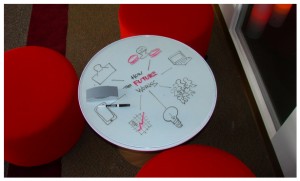Watch this space
Once again, We Media is designing new space.
There’s the physical space of weSpace, the co-working hub we’re launching for entrepreneurs and digital creatives. There’s the social space where we connect innovators through technology, collaboration and creativity. And there’s the space between the ears where we consider our place in a shape-shifting world. 
Space matters. It can inspire people to do great things. To engage one-another. To think more deeply. To innovate and make a difference. Space inspires us.
But like great expectation, great space just doesn’t happen. It unfolds in time. “The future enters us slowly, as if to transform us, long before it happens,” the poet Ranier Marie Ilke counseled.
Space must be designed. Carefully, bit by bit. Steve Jobs put it this way: Design isn’t how it looks, it’s how it works.
We Media emerged a decade ago with a prescient and somewhat ominous (at least for some) design: Networked technology would enable everyone to set the agenda for what we know, how we work and how we live. In the world we designed in 2002, control shifted from traditional institutions to everyday people. Media was democratized; power flowed to citizens.
Many people see this as the Internet revolution. It is, but not the way they think. While the “digital everything” was the first law of We Media back in 2002, it was also a foreshadowing of a social revolution to come. The age of access that we saw coming a decade ago is patently obvious today as people everywhere design or redesign their place in a connected society. The implications for just about everything are profound.
Design sits atop our agenda for the visible future. It is the way we interact with the world. It’s how and what we see, how we organize thought, how we translate concepts to others, how we create, how we express ourselves. Design brings us closer to communion with the ineffable in a period of enlightened anxiety.
Watch this space.



